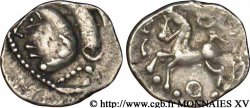- Accueil
- >
- >
bga_537001 - GALLIA - ÆDUI (BIBRACTE, Area of the Mont-Beuvray) Statère en bronze à la lyre, type de Chenôves
недоступный.
Товар уже продан в нашем интернет-магазине (2024)
Цена: : 275.00 €
Товар уже продан в нашем интернет-магазине (2024)
Цена: : 275.00 €
Тип Statère en bronze à la lyre, type de Chenôves
Дата: c. 70-50 AC.
Монетный двор / Город: Autun (71)
Металл: bronze
Диаметр: 18,5 mm
Ориентация осей монеты: 6 h.
Вес: 4,79 g.
Редкость: R2
Комментарии о состоянии
Usure marquée sinon bel exemplaire présentant un revers complet
Происхождение:
Exemplaire provenant de la vente Millon du 8 décembre 2008, lot 254
Лицевая сторона
Аверс: легенда: ANÉPIGRAPHE.
Аверс: описание: Tête humaine laurée à droite, la chevelure stylisée ; grènetis.
Обратная сторона
Реверс: легенда: ANÉPIGRAPHE.
Реверс: Описание: Cheval galopant à droite ; au-dessus du cheval, l'aurige ; lyre sous le cheval.
Комментарий
Traces de dorure. Ces monnaies du type de Chenôves se divisent en deux types ; à la lyre (classe I) ou à la rouelle (classe II).
Ce statère est très léger ; la densité de l’alliage semble très faible !.
Ce statère est très léger ; la densité de l’alliage semble très faible !.








 Cообщить об ошибке
Cообщить об ошибке Распечатать страницу
Распечатать страницу Отправить мой выбор
Отправить мой выбор Задать вопрос
Задать вопрос Consign / sell
Consign / sell
 Информация
Информация



